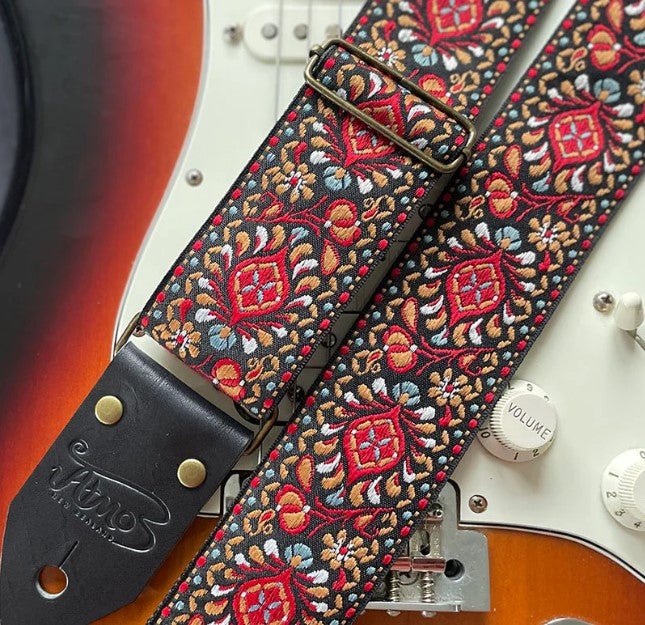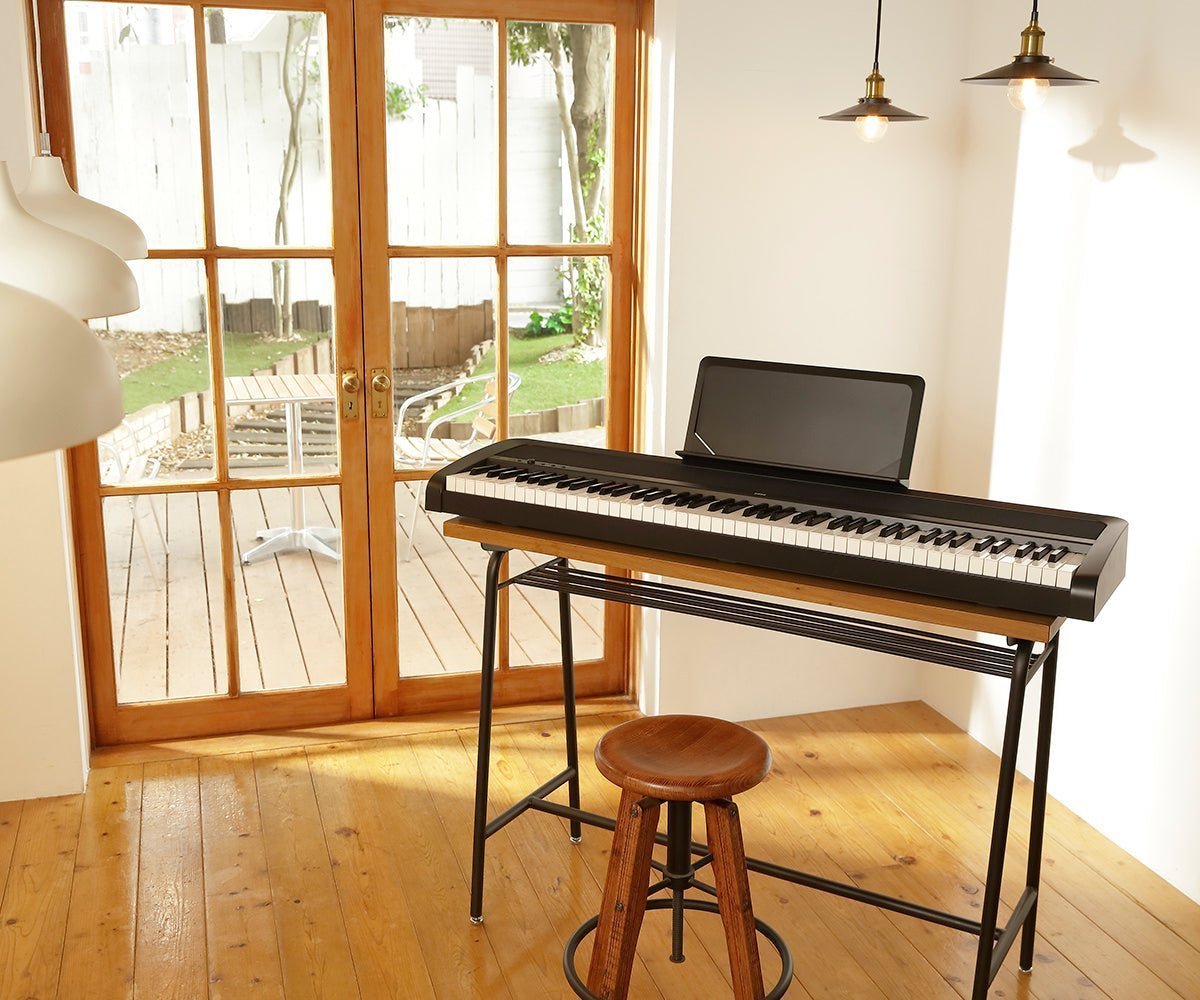Acoustic Guitar Buying Guide: How to Choose the Right One for You

Whether you're singing by the campfire, recording a heartfelt ballad, or playing on stage unplugged, the acoustic guitar is an enduring symbol of musical expression. Its warm, resonant tone and portability make it the go-to instrument for songwriters, beginners, and professionals alike. No cables, no pedals—just you and the music.
At Music Planet, we offer a wide selection of acoustic guitars for every style, budget, and experience level. In this guide, you'll learn how to choose the right model for your playing needs, understand key features, and get expert recommendations to match your skill level.
Types of Acoustic Guitars
Dreadnought
The dreadnought is the most popular acoustic guitar shape, offering a bold, full-bodied tone with excellent projection. Its larger body size enhances bass response and volume, making it perfect for strumming and singer-songwriters. However, its bulk may feel less comfortable for smaller players.
Best for: Folk, pop, rock, and country players who want strong sound and versatility.
Concert and Grand Concert
These guitars are smaller than dreadnoughts, with a more focused midrange tone. They’re lighter and easier to hold, especially for beginners or fingerstyle players. The grand concert offers slightly more depth and resonance than the concert.
Best for: Fingerpicking, light strumming, and smaller-framed players.
Auditorium and Grand Auditorium
Sitting between the concert and dreadnought sizes, these models balance clarity and projection. The grand auditorium, often considered the "Swiss army knife" of acoustic guitars, is highly versatile and handles a wide variety of genres with ease.
Best for: Players who want a well-rounded instrument suitable for both strumming and fingerstyle.
Travel or Parlor
Compact and lightweight, travel and parlor guitars are perfect for on-the-go players. While they lack the booming bass of larger models, they offer charming tone and comfortable playability.
Best for: Travel, casual play, and younger or smaller players.
Baritone Acoustic
Tuned lower than standard acoustics, baritone guitars offer deep, rich tones with extra resonance. They’re ideal for alternate tunings, cinematic compositions, or players looking to explore new sonic territory.
Best for: Advanced players, experimental songwriting, and extended range music
Choosing the right guitar for your needs
Beginners Learning at Home
New players benefit from guitars that are comfortable to hold, easy to play, and affordable. Instruments with a slightly smaller body size—like folk or concert styles—help reduce arm and shoulder fatigue. A smooth neck finish, low string action, and durable construction encourage longer practice sessions and build confidence early on.
Singer-Songwriters
If your goal is to write and perform original music, look for a guitar that delivers a balanced tonal range, with clarity in the highs and warmth in the mids. A solid top improves resonance and dynamic response, while grand auditorium or concert body shapes complement both fingerpicking and strumming. These shapes also sit well in a vocal mix, making them ideal for acoustic performances.
Gigging with Amplification
Performing live requires an acoustic-electric guitar with a reliable built-in pickup and preamp system. Look for features like onboard EQ, volume controls, and feedback reduction. A cutaway body allows access to higher frets, and solid wood construction ensures a rich, natural tone when plugged into a PA or acoustic amp.
Traveling and Busking
For musicians on the go, portability and resilience are essential. Choose a travel-size, parlor, or 3/4-size guitar for easier transport. Guitars with laminate bodies handle humidity and temperature changes better than solid wood, and padded gig bags offer protection without bulk. Lightweight builds also make extended playing more comfortable during street performances.
Low Tunings and Deep Tones
If you like experimenting with alternate tunings or want to explore a deeper, richer sound, a baritone acoustic is ideal. These guitars feature a longer scale length, which maintains proper tension in lower tunings, and heavier strings that deliver a growling low-end without sacrificing clarity. They’re perfect for cinematic compositions, fingerstyle bass lines, or moody songwriting.
Key Features to Consider
Body Shape and Size
The size and shape of the guitar impact comfort, tone, and projection. Larger bodies (like dreadnoughts) are louder and fuller, while smaller bodies (concert, parlor) are easier to hold and offer a more articulate response.
Why it matters: Body shape influences how your guitar feels and sounds, especially when choosing between strumming and fingerstyle.
How it varies: From the booming dreadnought to the crisp parlor, each body type has distinct tonal and ergonomic characteristics.
Top Wood (Soundboard)
The top of the guitar greatly affects tone. Solid tops (e.g., spruce, cedar) provide better resonance and improve with age. Laminate tops are more affordable and resistant to humidity.
Why it matters: The soundboard is the primary vibration surface—better wood means better sound.
How it varies: Spruce is bright and dynamic, cedar is warm and mellow, and mahogany is rich and woody.
Neck Profile and Scale Length
Neck shape affects hand comfort, while scale length affects tension and tone. Shorter scales (e.g., 24.75") are easier to play and bend, while longer scales (e.g., 25.5") offer tighter string tension and better low-end.
Electronics (for Acoustic-Electric Models)
Built-in pickups and preamps let you plug into amps, interfaces, or PAs. Some systems include tuners, EQ, and feedback control.
Why it matters: Acoustic-electrics provide stage and recording flexibility.
How it varies: Higher-end electronics offer better clarity, natural tone reproduction, and tone-shaping options.
Nut Width and String Spacing
Wider nuts allow more space between strings—great for fingerstyle. Narrower nuts suit strummers or players with smaller hands.
Why it matters: A proper fit makes chords, picking, and transitions smoother.
How it varies: Classical-style guitars typically have wider nuts, while steel-strings vary from 43mm to 45mm widths.
Recommendations by Skill Level
Acoustic Guitars for Beginners
Tanglewood Strada TS3 Folk Spruce Top Acoustic Guitar
View Product
Comfortable and responsive, the TS3 has a folk-sized body and a spruce top for bright, articulate tone. Ideal for first-time players who want a guitar that feels and sounds great right out of the box.
Alvarez RF26 Acoustic Guitar with Bag
View Product
A reliable entry-level guitar with balanced tone and excellent build quality. It includes a gig bag for portability and protection—great for students and casual players.
Acoustic Guitars for Advanced Musicians
Martin 00-X2E Acoustic-Electric Guitar Natural
View Product
From one of the most respected names in acoustic guitars, the 00-X2E combines beautiful tonewoods with cutting-edge electronics. Ideal for studio and stage, it delivers a warm yet articulate sound with superb playability.
Alvarez ABT60E Baritone Acoustic-Electric Guitar
View Product
This baritone acoustic-electric opens new creative territory for experienced players. Its deep voice and premium build quality make it perfect for expanded tunings and ambient compositions.
Popular Brands at Music Planet
Martin
Martin is synonymous with acoustic excellence. Known for their rich tones, solid construction, and timeless designs, Martin guitars are often the gold standard among professionals.
Target Audience: Intermediate to professional players who want unmatched tone and build quality.
Tanglewood
Tanglewood blends traditional design with innovative craftsmanship. Their guitars often feature solid tops and smooth playability at a very accessible price point.
Target Audience: Beginners and hobbyists seeking great tone and craftsmanship without the premium price tag.
D’Angelico
With roots in archtop jazz instruments, D’Angelico’s acoustics bring elegant design and tonal richness to the stage. Their unique body shapes and finishes stand out visually and sonically.
Target Audience: Players who want boutique-style guitars with style and performance to match.
Alvarez
Alvarez is known for high-quality guitars that offer tremendous value. With solid tops and thoughtful craftsmanship, they appeal to both beginners and discerning players alike.
Target Audience: All skill levels—from students to gigging musicians—looking for excellent quality-to-price ratio.
Accessories: What You Might Need with Your Acoustic Guitar
Gig Bags and Cases
A gig bag protects your guitar from bumps and climate changes. Hard cases offer even more security for air travel or pro gigs. Choose based on how often and where you travel with your guitar.
Guitar Straps
Even acoustic players benefit from a strap when standing. Look for adjustable, padded straps with leather ends to prevent slipping and wear.
Capos
A capo lets you change the key quickly without altering finger positions. Essential for singers and songwriters, especially in live settings.
Tuners
Keeping your guitar in tune is crucial. Clip-on tuners are small, affordable, and accurate—even in noisy environments.
Humidifiers
Acoustic guitars are sensitive to humidity. A soundhole or case humidifier protects against wood cracking and warping in dry climates.
Final Tips Before You Buy
Choosing the right acoustic guitar is a personal journey that should balance feel, tone, and budget. Think about where and how you’ll play—at home, on stage, or on the move—and choose a model that fits both your physical comfort and musical style. Solid tops and good craftsmanship will reward you with years of expressive tone
Visit a Music Planet store to try out different models or contact our experts online for personalized advice. Your perfect acoustic guitar is waiting to tell your story—string by string.
People Also Read
Frequently Asked Questions
Have a Question? We’ve Got the Answer!



